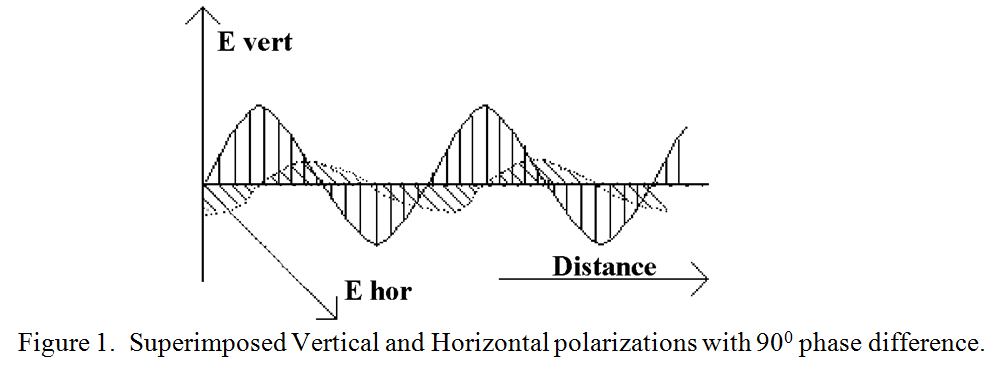| Back |
|---|

When the maximum amplitude of the vertical component is the same as that of the horizontal component, it is referred to as “circular polarisation”. It can be seen from the figure that by joining up the crests of the vertical and horizontal peaks, this results in a sort of corkscrew, (although in the case of figure 1 it is a left handed one). Reversal of the phase of either the vertical or horizontal component produces the opposite hand of polarization. There are several different aerial types which can produce circular polarization but they will not be described here as it is the intension of this article to describe the properties of the radiation rather than methods of producing it. Suffice it to say that an aerial designed to send and receive left hand circular polarization is as insensitive to the reception of right hand circular polarization as a vertically polarized aerial is to the reception of horizontal polarization. Either hand of circular polarization can of course be received by either a vertical or a horizontal aerial, but this incurs a 3dB loss.
There are situations where circular polarization has clear advantages over linear or plane polarization, for example, when communicating with an agile combat aircraft, a missile, or a rolling/tumbling satellite. As long at the target vehicle remains in the beam and within range, it will always receive a good signal when using circular polarisation whatever its roll angle.
The different reflection properties of horizontal and vertical polarization may be taken advantage of when using circular polarization. Because the horizontal component has its phase reversed when reflected off “moderately conducting” ground, whereas the vertical component does not, the hand of circular polarization is reversed after reflection off the ground. Thus the wave reflected off the ground cannot be received by a receiving aerial set for receiving the transmitted, (non reflected), signal. The fading which could result from destructive interference between the direct, and the reflected ray is therefore avoided. This property was made use of in VHF FM broadcasting by the BBC. Another characteristic of circular polarisation used to advantage in FM broadcasting is that small portable FM receivers can use compact telescopic aerials either vertical or horizontal, albeit with a 3dB loss compared to using a true circularly polarized aerial.
In principle, left hand and right hand circular polarization on the same frequency are completely independent. Hence two channels carrying different information may be sent on the same frequency. All that is required to receive both signals in separate channels is the ability of the receiving aerial to separate the two polarizations by combining the vertical and horizontal components with different phases.
Another useful property of circular polarization makes use of the fact that although a single reflection reverses the hand of the polarization, two, or any even number of reflections in sequence, restores it. Fortunately, complex radar targets such as land vehicles, ships and aircraft give rise to multiple reflections with random phase, which results in scrambling the incident polarization. Whereas rain drops act as point scatterers reversing the hand of polarization giving little received radar signal. Although this provides extremely satisfactory rain scatter rejection, the magnitude of the wanted target returns is also reduced by some 10 to 20dB, so a higher power radar transmitter is required. Unfortunately also, the tetrahedral “corner reflectors” often used to mark the runway threshold and other significant points on an airfield do not show up on rain rejecting radars without special modification. Such modification is slightly complicated and is beyond the scope of this article.
| Back |
|---|
PRAECEPTOR